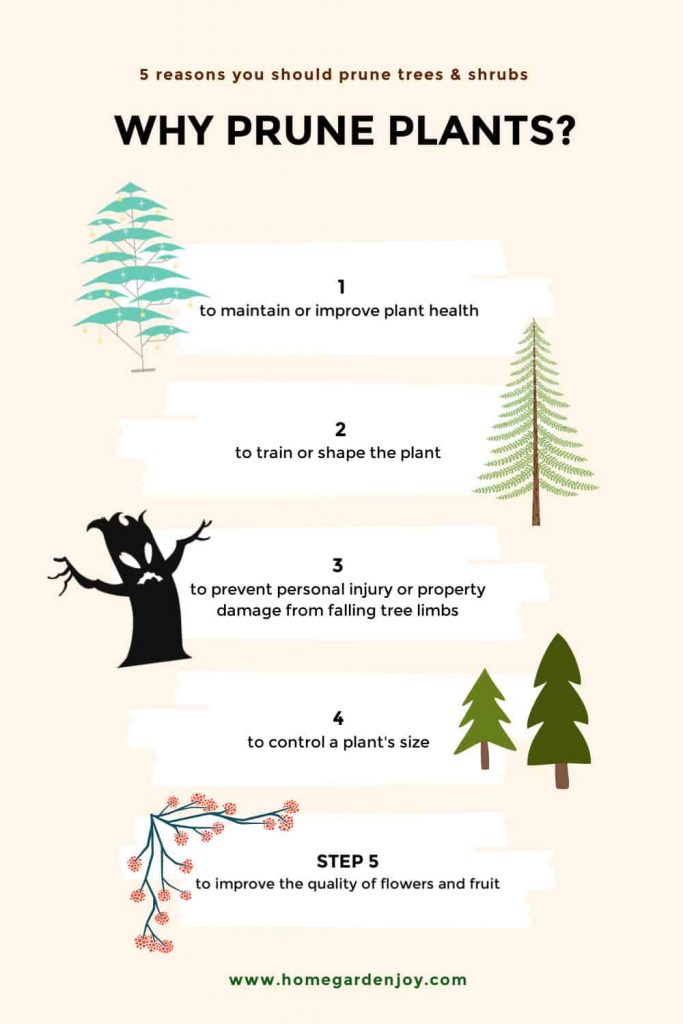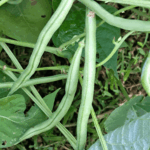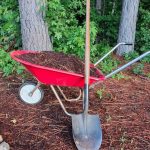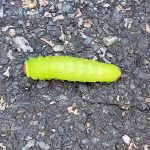What does pruning mean?
You’re reading along in your favorite gardening magazine or right here on Home Garden Joy when you read the word, “pruning.” You have a vague idea of what pruning means, but you aren’t sure exactly what it is, or how to do it. Yet it seems important. It’s in every gardening book, magazine, and blog.
What is pruning? Why do gardeners suggest pruning plants? What are the benefits of pruning?
Before grabbing your favorite pruning tools, it’s important to understand both the “why” and the “what” of pruning.
Your Guide to Pruning Trees, Shrubs, Flowers and Vegetables
People prune plants for many reasons. They can be pruned to shape the plant, improve its growth, enhance flower production, or even time flower production.
You can prune:
- Trees
- Shrubs
- Flowers
- Vegetables
This guide focuses mostly on pruning trees and shrubs.
What Is Pruning?
Pruning is the practice of trimming or shaping a tree or shrub.
In the wild, plants grow as far as light and space permit them to grow. Trees in the forest stretch up straight and tall, but somehow, maintain the proper distance among themselves. And, if a branch dies, it falls off, or it starts to decay, and insects hasten its demise. It falls harmlessly to the forest floor.
That same branch on a suburban street, however, poses a hazard to pedestrians, cars, and property if it should fall to the ground.
So what does pruning mean? It means cutting off branches that are diseases. It means shaping plants. And, it can mean keeping them contained.
What Is Pruning and What Pruning Tools Should You Use?

There are many great reasons to prune trees, shrubs, and other plants. What does pruning mean? It means to:
- Maintain or improve plant health.
- Train or shape the plant.
- Prevent personal injury or property damage from falling tree limbs.
- Control a plant’s size.
- Improve the quality of flowers and fruit.
Maintain or improve plant health
The first rule of thumb when pruning to maintain or improve plant health is to remove damaged or diseased branches. Dying branches weaken the tree. They attract insects. Insects bore into the dying branch, and birds such as woodpeckers tunnel into the wood to eat the insects. The result further weakens the branch, and it can become an entry point for disease and insects into the rest of the healthy plant.
By removing dead or diseased limbs, you can prune a plant to keep it healthy. Such maintenance is easier to do in the springtime before the tree or shrub leafs out (grows leaves). It’s easier to see the dead branches and any broken parts are clearly revealed.
Always disinfect pruning tools after use on one tree and before cutting into the next tree or shrub. This prevents the spread of microorganisms. Pour rubbing alcohol into a container, add a rag, and use the rag moistened with alcohol to clean the blades of your pruning tools before moving on to the next shrub.
Train or shape the plant
Everyone has seen topiaries, those shrubs shaped into objects. The sky’s the limit to a clever topiary artist. In the 17th century, topiary was all the rage through Europe. Gardens in England and France featured elaborate patterns of boxwood hedges trimmed into knots, pyramids, and other shapes to form flower beds. Today, you can find topiary in public parks, amusement parks, and other similar places. And many people shape their own – the round ball-shaped azalea is a form of topiary, one that I grew up with in the 1970s suburbs of Long Island, New York.
Topiary as an art shapes the plant by trimming new growth until the shrub is shaped according to the artist’s taste. It can take many years to form an elaborate shape. Any trimming can be done, however, to shape a plant. Apple trees are trimmed and shaped to create plenty of air and space between the branches, spacing them so that they are like the rungs of a ladder. Other trees may be shaped to maintain a pleasing shape.
Don’t forget Christmas trees! They’re also shaped by pruning.
Prevent personal injury or property damage
Falling branches can cause damage to personal property or to people. It’s a smart idea for homeowners to have a professional tree service prune their trees once a year or at least once every other year, especially if you have mature shade trees on your property with branches that may overhang a neighbor’s area. Any dead or diseased branches should be removed by a professional to prevent injury.
Control a plant’s size
One of the most common reasons for pruning is to control a plant’s size. Although it is always best to buy the right plant for the right spot, homeowners don’t always have that luxury. If you bought a house with nice foundation plantings, you may not want to replace them. But as time goes by, and the plants grow, they can encroach on windows, electrical meters, dryer vents, and other important things.
Homeowners often ask when they should prune plants like forsythia, lilacs, crepe myrtle, azaleas, and other flowering trees and shrubs. A good rule of thumb is to prune spring blooming shrubs immediately after they bloom. This ensures that you trim them back before they have a chance to set bud, or grow their new flower buds, for next year. Many spring shrubs produce next year’s flowers during the summertime. By pruning before they create their buds, you can trim without worrying about chopping off flowers.
If you do accidentally prune a flowering shrub at the wrong time of year and cut off the buds, don’t panic! You won’t have many (or any) flowers the following year, but the shrub should recover and bloom as usual if you don’t cut off the buds again.
Improve the quality of fruit and flowers
This is the reason we prune roses – to improve the quality of the flowers. Pruning trees and shrubs encourages the plant to put more energy into building fruit and flowers. Pruning fruit trees such as apple, peach, and pear trees allows the trees to produce bigger, sweeter, better fruit. Pruning roses and lilacs encourages more flowers. By reducing the number of branches, you’ll enable the plant to direct its resources towards flower and fruit production.
Pruning Is a Basic Gardening Skill
Pruning is one of those chores that many of us, myself included, tend to put off until the last minute. I know I have to prune our butterfly bushes as they are becoming so big they’re blocking the view of smaller plants behind them. I’ll start pruning when it gets a bit cooler, towards the end of September.
In the winter, usually in January and February, my husband and I head out into our fruit tree orchard with pruning tools, rubbing alcohol, and rags, and prune up the apple, pear, peach and other trees. It’s a labor of love, and one we enjoy doing together.
Sometimes it is hard to prune a beloved tree. It feels like you’re cutting off healthy branches – what a waste! I feel like that sometimes when I’m pruning the apple trees, but then I remember that pruning now means bigger, more abundant fruit later, a healthier tree, and a more beautiful tree. In the end, pruning is worth the time in what you and the trees and shrubs receive back in rewards.




